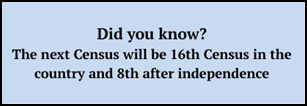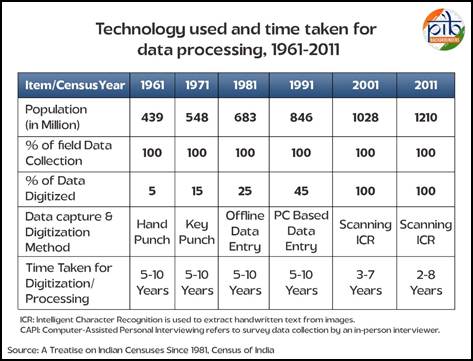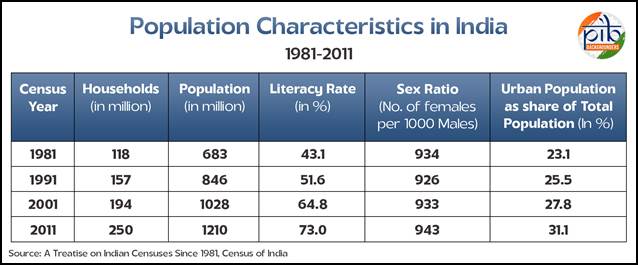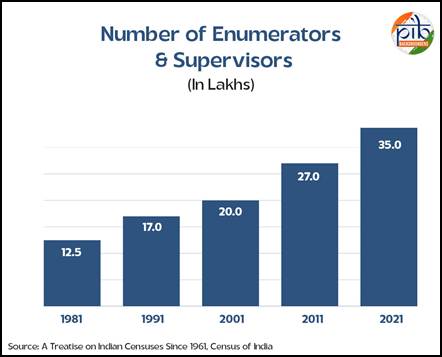Social Welfare
World Population Day 2025
The Next Big Step for India: Census 2027
Posted On:
11 JUL 2025 1:31PM
Key Takeaways
- World Population Day 2025 theme is “Empowering young people to create the families they want in a fair and hopeful world.”
- For India, the census will take place in 2027.
- Census was proposed to be conducted in 2021, however due to the outbreak of COVID-19, the census work was postponed.
- First fully digital census with mobile app and online self-enumeration.
- To include caste enumeration for all communities.
- More than 35 lakh field functionaries to be trained across India.
- Central monitoring portal and Code Directory for efficient data handling and early release of data.
- Two-phase rollout: Phase 1 i.e Houselisting & Housing census will start from April, 2026. Subsequently, Phase 2 i.e. Population enumeration will be conducted.
|
Introduction
World Population Day is celebrated every year on July 11. The theme for this year is “Empowering young people to create the families they want in a fair and hopeful world.” In India, the young population is set to form tomorrow’s workforce, with 65% of people under the age of 35. On June 16, 2025, the Ministry of Home Affairs officially issued the notification for Census 2027. The Indian Census is the largest single source of various statistical information on various characteristics of the people of India. With a history of more than 150 years, this reliable, time-tested exercise is bringing in a real insight into population data every 10 years.
Beginning in the year 1872, the first census was conducted at different times in different parts of India. The Indian Census has been a useful source of data for scholars and researchers in demography, economics, anthropology, sociology, statistics and many other disciplines. The rich diversity of India's people is indeed revealed by the decadal census, which has become a tool for understanding and studying India.
Ancient Foundations and Early Modern Census
India has a long and rich tradition of conducting censuses. The earliest references of conducting census in the country can be found in Kautilya’s ‘Arthashastra’ (321-296 BC) and later in the writings of Abdul Fazl’s in ‘Ain-e-Akbari’ during the days of Emperor Akbar.
The first modern population census in India was conducted between 1865 and 1872, though it didn't happen simultaneously across all regions. India conducted its first coordinated census in 1881.
Post-Independence Evolution (1951-2011)

Census is the biggest source of primary data at village, town and ward level providing micro level data on various parameters including Housing Condition; Amenities & Assets, Demography, Religion, SC & ST, Language, Literacy & Education, Economic Activity, Migration and Fertility. The Census Act, 1948 and the Census Rules, 1990 provide the legal framework for conduct of Census.

Did you know?
1951 Census- First Quality Check: Pioneered field re-checking to assess census accuracy - the first-ever attempt to verify how correct the count actually was.
1961 Census- Cultural Repository: Conducted extensive studies on rural crafts, fairs, festivals, and ethnographic surveys, transforming the Census Organisation into India's largest sociological information bank.
Mechanical Revolution: First census to use mechanical tabulation equipment including key punches, verifiers, sorters, and tabulators, marking India's early step toward automated data processing.
1971 Census- Migration Mapping: First census to systematically track internal migration by collecting data on people's last place of residence, providing crucial insights into India's population movement patterns.
1971 Census - Local Choice Research: Allowed each state's Director of Census Operations to conduct one special study of their choice, making the census more responsive to regional research needs.
Until 1991, only 45% of data could be digitised, However, in Census 2001 and 2011, the use of ICR technology made it possible to digitise all data that were collected from the field.
Key Observations from 1981-2011 Census’


Census 2011: Major Findings and Innovations
The Census 2011 was the 15th Census as reckoned from 1872 and the seventh since independence.The Complexity and Scale of Census 2011 operations are as follows:
- Multilingual Operations: The Census Schedules were surveyed in 16 different languages to accommodate India's linguistic diversity.
- Massive Printing Requirements: The exercise required printing of approximately 5.4 million instruction manuals and 340 million Census Schedules to support the nationwide operation.
- Extensive Human Resources: A workforce of 2.7 million enumerators and supervisors was engaged to carry out the census taking activities across the country.
- Geographic Coverage: The census operations spanned across:
- 35 States and Union Territories
- 640 districts
- 5,924 sub-districts
- 7,933 towns
- 6.41 lakh villages


- Unique Integration: Census 2011 featured a distinctive approach where Schedules for preparation of the National Population Register (NPR) were canvassed simultaneously with the Houselisting Schedules, making it a comprehensive demographic exercise.
- Logistical Achievement: The scale and complexity of coordinating such a massive operation across India's diverse geographical and linguistic landscape demonstrated the organizational capabilities of the census machinery.
Key demographic findings from Census 2011
- Total population: 1.21 Billion with males comprising 623.2 million and females 587.6 million , as of March 1, 2011.
- Population growth: 182 million increase during the decade 2001-2011.
- The child sex ratio was 918 females per thousand males in 2011.
- The population density of India in 2011 was 382 per sq km-decadal growth of 17.7 percent.
- The literacy rate in the country is 73.0 per cent, 80.9 for males and 64.6 for females. Kerala retained its position by being on top with a 94.0 per cent literacy rate, closely followed by Lakshadweep (91.8 per cent) and Mizoram (91.3 per cent).

Socio-Economic and Caste Census (SECC) 2011
Conducted by the Ministry of Rural Development, SECC-2011 was a study of the socio-economic status of rural and urban households and ranking of households based on predefined parameters. The Census in rural areas was conducted by Dept. of Rural Development, in urban areas by Ministry of Housing and Urban Affairs. Office of the Registrar General and Census Commissioner of India under the Ministry of Home Affairs provided technical support for SECC. The purpose of SECC-2011 was to enable evidence-based policy making, targeted delivery of welfare schemes, and efficient identification of beneficiaries for various government programmes. It included caste enumeration, but names of caste/tribe/religion were not shared publicly.
The SECC 2011 was a unique paperless Census utilizing over 6.4 lakh electronic handheld devices for enumeration. This groundbreaking exercise demonstrated robust grievance redressal mechanisms, processing 1.24 crore claims and objections with 99.7% resolution rate.
Revolutionary Changes in Census 2027
Caste Enumeration
For the first time since independence, Census 2027 will include caste enumeration for all individuals. Caste except Scheduled Caste (SC) and Scheduled Tribes (ST) has been excluded from all census operations conducted since independence. Some states have conducted caste surveys with varying transparency and intent, raising concerns of politicization. To protect social harmony, it has been decided to include caste enumeration in the main census rather than as a separate survey.
Digital Transformation
Census 2027 represents a paradigmatic shift as India's first digital census. The government has announced several technological innovations-
- First-time use of Mobile Apps for data collection.
- Census Monitoring & Management Portal with multilingual support.
- Online self-enumeration for the public for both phases of Census.
- Code Directory to streamline data processing.
- Training of more than 35 lakh field functionaries.
- In-built validation check mechanism
Operational Framework
The census will be conducted in two distinct phases:
- The reference date for the census shall be 00.00 hours (12 AM midnight) of the 1st day of March, 2027 except for the Union Territory of Ladakh and snow-bound areas of Union Territory of J&K, and the states of Himachal Pradesh, and Uttarakhand.
- For the Union Territory of Ladakh and snow-bound areas of Union Territory of J&K, and the states of Himachal Pradesh, and Uttarakhand, the reference date shall be 00:00 hours (12 AM midnight) of the 1st day of October, 2026.
Conclusion
As India prepares for Census 2027, the nation stands at a historic juncture where years of unbroken census tradition meets revolutionary digital transformation. This groundbreaking exercise introduces comprehensive caste enumeration for the first time since independence, mobile app-based data collection, and online self-enumeration facilities, representing the most ambitious demographic undertaking in India's history. Census 2027 will not only establish new global benchmarks for large-scale population exercises but also serve as a cornerstone for inclusive governance and evidence-based policy formulation, ensuring that India's diverse population is accurately represented in the digital age.
References:
Census India:
President’s Secretariat:
Cabinet:
Ministry of Home Affairs:
Ministry of Finance:
Others:
Click here to see in PDF
SK/RK
(Backgrounder ID: 154867)
Visitor Counter : 10853
Provide suggestions / comments